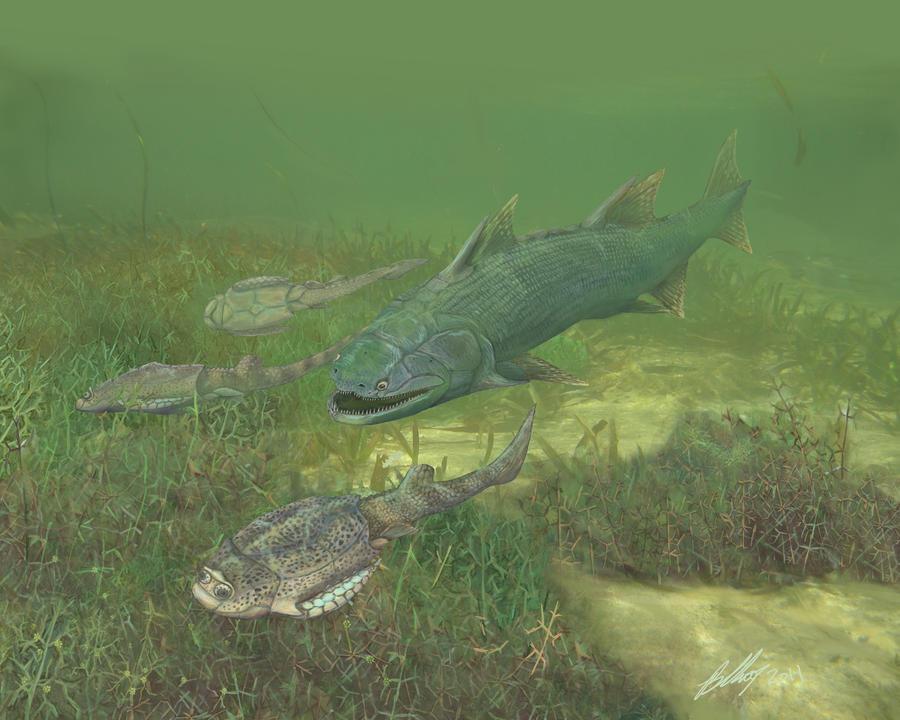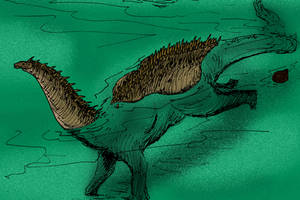ShopDreamUp AI ArtDreamUp
Deviation Actions
Suggested Deviants
Suggested Collections
You Might Like…
Featured in Groups
Description
2011, acrylics on card, digital & photography
ca 413 million years ago, Early Devonian (Lochkovian), Xitun Formation, Yunnan, China
Over a shallow, coastal seabed, a trio of 7 cm long antiarchs called Parayunnanolepis flee at the approach of a pugnacious Psarolepis. Over 400 million years later, fossils of Parayunnanolepis will greatly improve our understanding of early gnathostome evolution.
Antiarchs are a Silurian-Devonian group of jawed fishes characterised by their box-like exoskeletons and armoured pectoral fins. Traditionally considered as placoderms, some recent analyses resolve them as the most primitive of all the jawed vertebrates (ie. Antiarchs are the sister-group to all other backboned critters with jaws).
This has profound implications for early gnathostome evolution as until recently it was widely accepted that antiarchs lacked pelvic fins. The soft post-thoracic anatomy of antiarchs (the bit containing the pelvic fins) is rarely preserved but they are known to be absent on several completely known Middle-Late Devonian "advanced" (=euantiarch) antiarchs. Note that popular reconstructions of the euantiarch Bothriolepis often have small pelvic fins but this interpretation has been recently questioned (they are not visible on the majority of specimens).
So.... IF antiarchs branched off before the evolution pelvic fins AND the phylogenetic models that places antiarchs at or near the base of the gnathostome radiation are correct, this would suggest that paired pelvic appendages evolved long after the appearance of jaws.
Then along came Parayunnanolepis.
Parayunnanolepis xitunensis is an extremely important fossil taxon as it represents the only primitive (non-euantiarch) antiarch known from a complete articulated specimen down the the tip of the tail. In short, despite initial descriptions to the contrary, this fish had pelvic fins!. The fins themselves are not preserved but both pelvic girdles (which supported the fins) are. So we now know that the earliest antiarchs DID have pelvic fins that were secondarily lost in some of the later forms.
Thus - regardless of where you stick the antiarchs on your cladogram, there is now no evidence that pelvic fins (the precursors of your legs) evolved after the appearance of moveable jaws.
For more info, read: Min Zhu, Xiaobo Yu, Brian Choo, Junqing Wang and Liantao Jia (2012) An antiarch placoderm shows that pelvic girdles arose at the root of jawed vertebrates. Biology Letters. available online at:
[link]
OTHER TAXA IN THE PICTURE:
Psarolepis romeri is a very primitive predatory bony fish (either a stem-sarcopterygian or stem-osteichthyan) .
The seaweed is Uncatoella verticillata, a charophyte alga with distinctive whorled branchlets and berry-like reproductive capsules. It is a common plant fossil in the Xitun and the earlier Xiaxishancun Formation.
copyright 2012, Brian Choo
ca 413 million years ago, Early Devonian (Lochkovian), Xitun Formation, Yunnan, China
Over a shallow, coastal seabed, a trio of 7 cm long antiarchs called Parayunnanolepis flee at the approach of a pugnacious Psarolepis. Over 400 million years later, fossils of Parayunnanolepis will greatly improve our understanding of early gnathostome evolution.
Antiarchs are a Silurian-Devonian group of jawed fishes characterised by their box-like exoskeletons and armoured pectoral fins. Traditionally considered as placoderms, some recent analyses resolve them as the most primitive of all the jawed vertebrates (ie. Antiarchs are the sister-group to all other backboned critters with jaws).
This has profound implications for early gnathostome evolution as until recently it was widely accepted that antiarchs lacked pelvic fins. The soft post-thoracic anatomy of antiarchs (the bit containing the pelvic fins) is rarely preserved but they are known to be absent on several completely known Middle-Late Devonian "advanced" (=euantiarch) antiarchs. Note that popular reconstructions of the euantiarch Bothriolepis often have small pelvic fins but this interpretation has been recently questioned (they are not visible on the majority of specimens).
So.... IF antiarchs branched off before the evolution pelvic fins AND the phylogenetic models that places antiarchs at or near the base of the gnathostome radiation are correct, this would suggest that paired pelvic appendages evolved long after the appearance of jaws.
Then along came Parayunnanolepis.
Parayunnanolepis xitunensis is an extremely important fossil taxon as it represents the only primitive (non-euantiarch) antiarch known from a complete articulated specimen down the the tip of the tail. In short, despite initial descriptions to the contrary, this fish had pelvic fins!. The fins themselves are not preserved but both pelvic girdles (which supported the fins) are. So we now know that the earliest antiarchs DID have pelvic fins that were secondarily lost in some of the later forms.
Thus - regardless of where you stick the antiarchs on your cladogram, there is now no evidence that pelvic fins (the precursors of your legs) evolved after the appearance of moveable jaws.
For more info, read: Min Zhu, Xiaobo Yu, Brian Choo, Junqing Wang and Liantao Jia (2012) An antiarch placoderm shows that pelvic girdles arose at the root of jawed vertebrates. Biology Letters. available online at:
[link]
OTHER TAXA IN THE PICTURE:
Psarolepis romeri is a very primitive predatory bony fish (either a stem-sarcopterygian or stem-osteichthyan) .
The seaweed is Uncatoella verticillata, a charophyte alga with distinctive whorled branchlets and berry-like reproductive capsules. It is a common plant fossil in the Xitun and the earlier Xiaxishancun Formation.
copyright 2012, Brian Choo
Image size
3543x2834px 4.96 MB
Make
Canon
Model
Canon PowerShot S50
Shutter Speed
1/807 second
Aperture
F/2.8
Focal Length
7 mm
Date Taken
Dec 29, 2007, 1:18:42 PM
Sensor Size
9mm
© 2012 - 2024 Gogosardina
Comments37
Join the community to add your comment. Already a deviant? Log In
Could anyone inform me of the size of psarolepis?
































